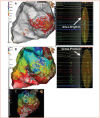Dynamic High-density Functional Substrate Mapping Improves Outcomes in Ischaemic Ventricular Tachycardia Ablation: Sense Protocol Functional Substrate Mapping and Other Functional Mapping Techniques
- PMID: 33936742
- PMCID: PMC8076974
- DOI: 10.15420/aer.2020.28
Dynamic High-density Functional Substrate Mapping Improves Outcomes in Ischaemic Ventricular Tachycardia Ablation: Sense Protocol Functional Substrate Mapping and Other Functional Mapping Techniques
Abstract
Post-infarct-related ventricular tachycardia (VT) occurs due to reentry over surviving fibres within ventricular scar tissue. The mapping and ablation of patients in VT remains a challenge when VT is poorly tolerated and in cases in which VT is non-sustained or not inducible. Conventional substrate mapping techniques are limited by the ambiguity of substrate characterisation methods and the variety of mapping tools, which may record signals differently based on their bipolar spacing and electrode size. Real world data suggest that outcomes from VT ablation remain poor in terms of freedom from recurrent therapy using conventional techniques. Functional substrate mapping techniques, such as single extrastimulus protocol mapping, identify regions of unmasked delayed potentials, which, by nature of their dynamic and functional components, may play a critical role in sustaining VT. These methods may improve substrate mapping of VT, potentially making ablation safer and more reproducible, and thereby improving the outcomes. Further large-scale studies are needed.
Keywords: Ventricular tachycardia; ablation; functional substrate mapping; substrate mapping.
Copyright © 2021, Radcliffe Cardiology.
Conflict of interest statement
Disclosure: NTS has received speaker fees from Abbot. NP has no conflicts of interest to declare.
Figures






Similar articles
-
Novel Mapping Strategies for Ventricular Tachycardia Ablation.Curr Treat Options Cardiovasc Med. 2018 Mar 23;20(4):34. doi: 10.1007/s11936-018-0615-1. Curr Treat Options Cardiovasc Med. 2018. PMID: 29572643 Review.
-
The value of functional substrate mapping in ventricular tachycardia ablation.Heart Rhythm O2. 2022 Nov 2;4(2):134-146. doi: 10.1016/j.hroo.2022.10.013. eCollection 2023 Feb. Heart Rhythm O2. 2022. PMID: 36873315 Free PMC article. Review.
-
Substrate characterization and catheter ablation in patients with scar-related ventricular tachycardia using ultra high-density 3-D mapping.J Cardiovasc Electrophysiol. 2017 Sep;28(9):1058-1067. doi: 10.1111/jce.13270. Epub 2017 Jul 3. J Cardiovasc Electrophysiol. 2017. PMID: 28597532
-
Targeted Ablation of Ventricular Tachycardia Guided by Wavefront Discontinuities During Sinus Rhythm: A New Functional Substrate Mapping Strategy.Circulation. 2019 Oct 22;140(17):1383-1397. doi: 10.1161/CIRCULATIONAHA.119.042423. Epub 2019 Sep 19. Circulation. 2019. PMID: 31533463
-
Targeting the Hidden Substrate Unmasked by Right Ventricular Extrastimulation Improves Ventricular Tachycardia Ablation Outcome After Myocardial Infarction.JACC Clin Electrophysiol. 2018 Mar;4(3):316-327. doi: 10.1016/j.jacep.2018.01.013. Epub 2018 Mar 19. JACC Clin Electrophysiol. 2018. PMID: 30089556
Cited by
-
Secret signal delayed mapping in patients with premature ventricular contractions.Postepy Kardiol Interwencyjnej. 2024 Jun;20(2):194-200. doi: 10.5114/aic.2024.140265. Epub 2024 Jun 4. Postepy Kardiol Interwencyjnej. 2024. PMID: 39022705 Free PMC article.
References
-
- Soejima K,, Stevenson WG,, Maisel WH, et al. Electrically unexcitable scar mapping based on pacing threshold for identification of the reentry circuit isthmus: feasibility for guiding ventricular tachycardia ablation. Circulation. 2002;106:1678–83. doi: 10.1161/01.CIR.0000030187.39852.A7. - DOI - PubMed
Publication types
LinkOut - more resources
Full Text Sources
Other Literature Sources

